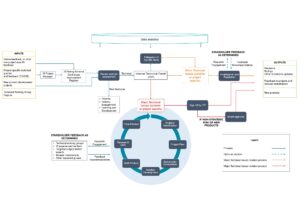Purpose
This document describes the Infrastructure Sustainability Council (ISC) continuous improvement and technical governance processes for the ongoing development of the IS Rating Scheme. These processes allow the ISC to respond transparently and consistently to stakeholders engaged in projects and/or the ongoing development of the IS Rating Scheme and Tools.
Learning Approach
The use of market testing and feedback to develop products iteratively and efficiently is broadly accepted as a best practice approach to ensure a product satisfies its market’s needs. The Learning and Analytics Loop overviews the steps in our continuous improvement process: receive and triage feedback, analyse relevant data, prioritise the ISC’s responses and efforts, and allow a transparent and timely response to scheme users and stakeholders.
The Learning and Analytics Loop aligns with the ISC values of being collaborative, dynamic and responsible. We track time taken to respond to and close out feedback as a key performance metric.
To ensure our technical governance process operates efficiently, the ISC refines its internal processes, for example having clear delegations of authority in place to manage risks, aligns with ISEAL processes, and remains as responsive as possible to market feedback. The following pages describe the detailed process for technical governance and managing continuous improvement.
Technical Governance Framework: Internal process overview, feedback pathways & delegations of authority
Definitions: Feedback Process
TABLE 1 outlines the definitions for categorising feedback. These definitions help determine the appropriate pathway and subsequent delegations of authority as shown in the Technical Governance Framework Diagram.
TABLE 1 FEEDBACK DEFINITIONS
|
Feedback Type |
Definition |
| Credit Interpretation Request (CIR) | A credit interpretation request is a proposal for an alternative yet equivalent method to meet the aim of a credit requested outside of an ISC rating. If approved, a credit interpretation request may result in a published ruling which will be incorporated into subsequent versions of the IS Technical Manuals or may result in a project-specific CIR. |
| Technical Clarification (TC) | A technical clarification is a request made by a stakeholder seeking clarification on credit requirements outside of an ISC rating, these are generally project specific. Technical clarifications are submitted when further guidance is sought in the technical manuals. If approved, a technical clarification may result in a published ruling which will be incorporated into subsequent versions of the IS Technical Manuals. |
| Queries | Are requests that seek clarity on a provision of the Technical Manual or element of the IS Rating Scheme. These are low risk and of lower order than a technical clarification. |
| Minor technical revision | A minor revision to an IS credit and/or guidance document. A minor revision is defined as a change that would provide clarity or minor improvement to the interpretation of an IS credit or criteria. No significant change in practice would be required by industry in the application of the revision. |
| Major/Substantive technical revision | Substantive revisions are material changes to the rating scheme that would significantly shift expectations or change practices by industry. Substantive revisions to the rating scheme require the Proposal to Revise form to be completed and approved by ISC. Examples of a substantive revision may include a revision of themes, categories or credits in the IS Technical Manuals or proposing alternative verification processes. |
| Technical Working Group (TWG) outputs | The ISC Technical Working Groups are formed with industry stakeholders. Their purpose is to enable and assist ISC’s continuous improvement processes and innovation. Their outputs include analysis, recommendations, and reports on matters relevant to the IS Rating Scheme (e.g. current challenges, future directions, capability building, stakeholder views, specific infrastructure sustainability topics). |
Definitions: Groups and Stakeholders
The following table includes definitions on the internal and external stakeholders included in the Technical Governance Framework diagram.
| Entity/Group | Description |
| IS Project Manager | The primary point of contact at ISC for the Assessor and Verifiers throughout the rating process. |
| ISC Board | The ISC Board has overall responsibilities in relation to finance, audit and risk management matters arising out of current activities and future opportunities undertaken by ISC. It is also responsible for reviewing and providing oversight of all high-risk operational items relating to existing products. |
| Internal Technical Panel (ITP) | A panel consisting of the following people within the ISC:
1) Chief Impact Officer (Chair) 2) IS Technical Director (Deputy Chair) 3) Plus one other – a Senior Member of the Technical Team or Rating Team State Lead (can change amongst this group) |
| Subject Matter Expert | An expert in their respective field of knowledge. |
| External Stakeholder Group/s | Individuals and/or (representatives of) groups which affect or can be affected by infrastructure assets. These include but are not limited to: organisations in the infrastructure sector both public and private, indigenous peoples, environmental and social non-government organisations. |

